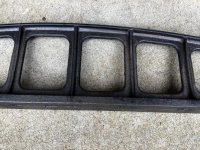Old Lucy here has some serious leaks around the door. There are so many firebrick repair products out there, I don't know where to start. It is so crumbly, it would be easy to make it worse.
Any experience? This is a 2000F heat treat furnace, so no fireplace goop allowed. Even ceramic kiln stuff is suspect. I would consider just packing the gap with asbestos cloth. I would rather consider a multi-step process if it is really better than one step. Seen a video using runny gray cement, followed by trowel-on white stuff, then sanded & glazed with a third substance. The only thing I don't want to do is replace whole slabs, the entire kaboodle would disintegrate.

Also (breaking forum rules), any advice about case hardening in here? I've only done various alloys with Tool Wrap. We have Kasenit or Cherry Red or something that we use with a torch. Just submerge the 1018 in an open pan? Can case compound be re-used? Ever bother tempering Kasenit after quench? Ever get banned for asking too many questions in one post?
Any experience? This is a 2000F heat treat furnace, so no fireplace goop allowed. Even ceramic kiln stuff is suspect. I would consider just packing the gap with asbestos cloth. I would rather consider a multi-step process if it is really better than one step. Seen a video using runny gray cement, followed by trowel-on white stuff, then sanded & glazed with a third substance. The only thing I don't want to do is replace whole slabs, the entire kaboodle would disintegrate.

Also (breaking forum rules), any advice about case hardening in here? I've only done various alloys with Tool Wrap. We have Kasenit or Cherry Red or something that we use with a torch. Just submerge the 1018 in an open pan? Can case compound be re-used? Ever bother tempering Kasenit after quench? Ever get banned for asking too many questions in one post?





